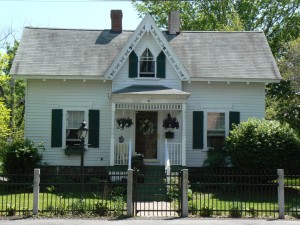What Style is Your House: Gothic Revival
| . Posted in advice - 0 Comments
Courtesy of Worcester Heritage Preservation Society
In the 1830s, new technology like the circular-saw, machine-made nails, and the jig-saw made possible new and cheaper building techniques. Wood-stoves became popular and so chimneys no longer had to be so massive.
The invention of balloon frames, consisting of a cage-like frame of two by fours to which a roof and siding were nailed, allowed as few as two men to build a house quickly and economically. Although critics said the houses would “blow away like balloons,” the new framing technique revolutionized the building industry. It allowed complex houseplans that could extend in almost every direction with projecting bays, towers and rooms.
People slowly grew tired of classical motifs and yearned for a more exotic and romantic look. Architects set aside the rules of ancient Greece and began the Gothic Revival, borrowing features from medieval castles and cathedrals. Although some Americans built miniature castles, most Gothic Revival houses are modest “cottages”, based loosely on Gothic church architecture and the English country cottage.
Home owners chose designs for the structure and trim from pattern books which local craftsmen then copied in wood, giving the houses the name “carpenter Gothic.” The style, which was fashionable between 1830 and 1860 never attained the popularity of the Greek Revival and Italianate styles.
Gothic Revival houses are often fanciful creations resembling fairy-tale cottages. Look for vergeboards, those lacy decorations hanging along the edge of gables, bringing to mind Hansel and Gretel’s “gingerbread” house. Vergeboards come in a wide variety of patterns, including vines, flowers, lacy loops and icicles. Look for tall, steep gable roofs with pinnacles and pendants, vertical siding called board and batten, stained glass and pointed arches on windows and doorways. Often you can also find drip moldings over windows and doors, trefoil windows, diamond shaped panes, porches and bay windows.




